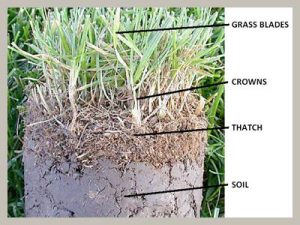Is your lawn looking as good as it should be for the middle of summer? Let’s look at some of the common problems and how to deal with them.
You really should be enjoying your garden to the full at this time of year. The days are long, the weather is warm and your garden should be looking great and inviting you outside. However, if you are really honest, what score would you give your lawn out of ten and would you really like it to be scoring a little higher?
I look at a lot of lawns and I meet a lot of people who are disappointed with their lawn and want to see some improvement. Many feel that there is no option other than lifting their existing lawn and starting again from scratch. However much can be achieved through lawn renovation which is generally far more cost effective and less intrusive than completely re-seeding or re-turfing your outside space.
So, you may be wondering what to look for in your lawn and what can be done to improve it. Generally I group my assessments into three main areas to see what needs attention and where improvements can be made.
Thatch

Thatch is a layer of organic matter, typically dead moss, dead or dying grass, stems, roots and other plant life, between the surface of the soil and the green living grass leaves above. In some lawns this layer can be quite thick and prevents water and nutrients from penetrating through to the soil below. Excessive thatch causes the soil to dry out and your lawn grass plants to suffer as a result. Some thatch is a good thing as it protects the soil and growing lawn. However, too much thatch is a common lawn problem that needs to be dealt with appropriately.
Thatch is dealt with through scarification with a garden rake for smaller areas, or a mechanical scarifer for larger lawns or more intensive removal. This process tears out the dead plant life and opens up the soil surface. It’s a tough job and your lawn will look a little battered for a short while afterwards, but the long-term improvements are essential if you want to enjoy a healthy luscious lawn in the future.
Compaction and drainage
Regular foot traffic over your lawn will compact the soil structure, resulting in fewer air gaps in the soil, restricting the flow of water and nutrients through the soil to the roots of your grass. Compacted lawns dry out more quickly and support fewer beneficial insects and worms. They have lower counts of essential microbes required to break down dead plant life, resulting in a build-up of thatch. The symptoms of compaction are thin, stressed turf grasses that are more susceptible to disease and pests, allowing gaps in the turf for weed seeds to germinate. In addition, compaction can result in waterlogging due to poor drainage and this encourages moss growth.
Compaction is dealt with through aeration of the lawn, either with a garden fork for smaller lawn areas or a mechanical aerator for a more effective result. It’s hard work, but the benefits to your lawn are invaluable.
Nutrition and pH
All plants need the correct nutrition to live a healthy and disease free life. All too often I visit lawns that never receive any supplementary nutrition or perhaps get a general sprinkle of something from the garden centre once a year. The home-owner wonders why their lawn looks so poor, and the grass is almost starving to death through malnutrition!
pH is the measure of the acidity of any given compound. Ranging from 1 which is acidic to 14 which is alkaline. The issue is, that a pH imbalance can ‘lock-up’ essential plant nutrients, making them unavailable to the growing lawn grasses and no amount of additional fertiliser is going to address the nutritional issues.
When recommending a lawn nutrition treatment plan I always test pH levels and ensure any underlying pH issues are resolved before nutrition begins.
If your lawn isn’t offering you as much satisfaction as it should then now is the time to think about addressing any underlying issues. As we approach the warm, wetter autumn weather and beyond, grasses respond well to repair work. Speak with a lawn care professional who can make a full assessment of your lawn and offer guidance on what reparation works will benefit your lawn through the winter and heading into spring. You may be surprised by how cost effective this approach is, and by this time next year perhaps your lawn score will be closer to a ten.

 Established 2016
Established 2016



